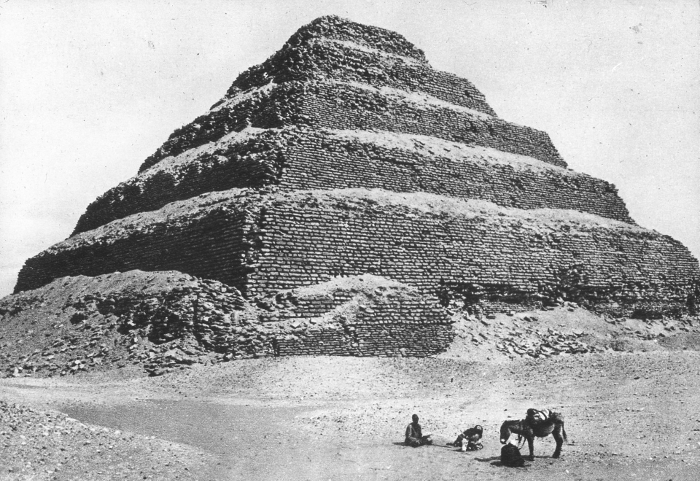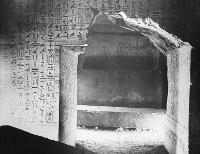Saqqara: Ancient Egypt's Burial Ground at Memphis
Saqqara was a large burial ground associated with the ancient Egyptian capital of Memphis. The earliest kings were buried at Abydos, farther south along the Nile. During the Third Dynasty, the kings of Egypt built tombs and funerary complexes at Saqqara. The most famous of these early monuments was the Step Pyramid of Djoser. 
It was the first king's tomb not to be a simple rectangular chamber known as a mastaba. Imhotep's design was a series of mastabas built on top of one another. For each level going up, the mastaba was slightly smaller; the result looked a number of large steps going up. Also, Djoser's "steps" were made of limestone, not clay bricks, as had been the standard for king's tombs. Carved into the limestone were images of reeds and trees. The builders inscribed Imhotep's name on the pyramid. When it was completed, Djoser's Step Pyramid was 204 feet tall. The temple was the main element of a building complex, which also contained a temple and housing for its priests and various shrines. Djoser was buried deep within the pyramid, in a chamber of granite. Later kings chose to build tombs at Saqqara, and some of those tombs were pyramidic in shape as well. A list of those kings includes Sekhemkhet, Userkaf, Djedkare, Teti, Pepi I, and Pepi II. Historians generally divide the 3.5-square-mile Saqqara area into two parts, Saqqara North and Saqqara South. The Step Pyramid is in the northern part. One unique feature in the tomb of Shepsekaf, which had more of a rectangular (and, therefore, mastaba) shape than his immediate predecessors, who chose to build pyramid-shaped tombs. 
Another well-known pyramid found at Saqqara is that built for Unas, the last king of the Fifth dynasty. Time and winds have eroded the surface of the tomb, but archaeologists have found inside a number of inscriptions known as the "Pyramid Texts," which many historians think are the oldest known descriptions of Egyptian religious practices. Later kings adopted the practice of installing such carvings on the walls of their tombs. Near the Pyramid of Unas are the Double Mastaba of Nebet and Khenut, Unas's wives. As before, nobles continued to erect their tombs at Saqqara. That practice continued when Memphis was not the capital, as happened periodically during Egypt's history. The famous general Horemheb had built his tomb at Saqqara; however, because he was later a pharaoh, he was eventually buried in the Valley of the Kings, the final resting place of many of Egypt's most famous rulers. Giza, site of the Great Pyramid, was another site on which pharaohs had built their tombs. Saqqara continued to be the choice of tomb and monument builders into Roman times. One later feature at Saqqara was the Serapeum, a temple dedicated to the Greco-Egyptian god Serapis, promoted by Ptolemy I as a means to promote religious similarity between the two cultures. Archaeologists have found within the tombs at Saqqara many well preserved drawings. Also found at a site named Abwab el-Qotat were several hundred mummified cats. |
|
Social Studies for Kids
copyright 2002–2025
David White




